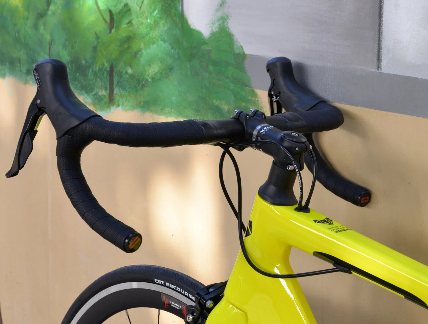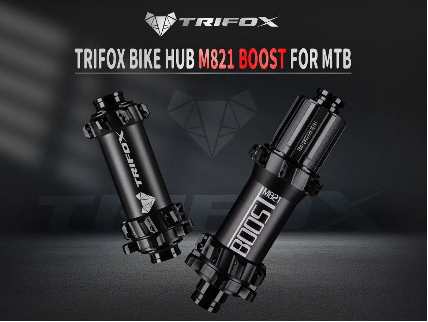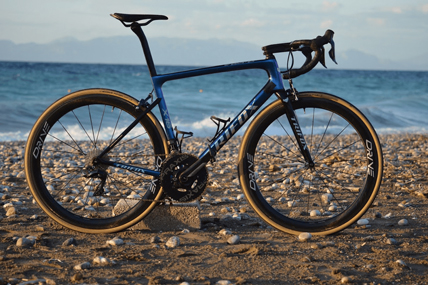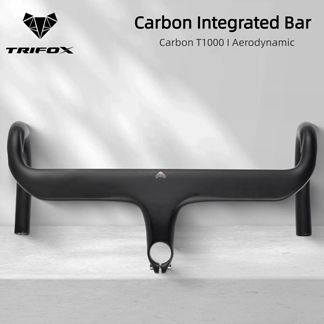
Upgrading your cockpit shouldn't feel like solving a complex puzzle. A stem that doesn't fit your handlebar can turn an exciting upgrade into a frustrating ordeal. This guide will demystify the key standards and explain how a versatile component like the Trifox Alloy Light Stem ABS300 is designed for broad, hassle-free compatibility.The Core Standard: Handlebar Clamp DiametersThe most critical check is the stem-to-handlebar fit. The industry uses two main diameters:• 31.8mm (The Universal Standard): The default for most modern mountain bike stems and road bike stems. It offers a great balance of stiffness and weight.• 35mm (The Oversized Standard): Used on some high-end bikes for maximum stiffness.The Trifox ABS300 features a 31.8mm handlebar clamp, making it instantly compatible with the widest range of handlebars.Compatibility Checklist: What Works with the ABS300Here’s a quick guide to what fits:• Handlebars: Any standard 31.8 mm stem diameter bar (most MTB and road bars).• Fork Steerer: Standard 1-1/8" (28.6mm) threadless forks.• Shift/Brake Levers: All major brands (Shimano, SRAM). Levers mount to the bar, independent of the stem.• Use: Designed for both mountain and road bikes.Precision Matters: The Role of TolerancesTwo parts listed as 31.8mm might not fit perfectly due to manufacturing tolerances (allowed margin of error). Low-quality stems with poor tolerances can lead to unsafe, uneven clamping. The Trifox ABS300 is precision CNC-machined with extremely tight tolerances. This guarantees a perfect, secure fit with standard bars—no shims, no guesswork, just safe and reliable performance.Pro Installation Tips for a Safe Fit1. Clean Surfaces: Wipe the bar and stem clamp with isopropyl alcohol.2. Check Alignment: Center the handlebar in the stem.3. Torque to Spec (CRUCIAL): Always use a torque wrench. Tighten bolts gradually in a cross pattern. - For Aluminum Bars: Typically 5-6 Nm. - For Carbon Bars: Use carbon assembly paste and torque to spec (check bar manual).Conclusion: Compatibility Equals ConfidenceChoosing a stem like the Trifox ABS300 eliminates compatibility guesswork. Its universal 31.8mm standard, precise manufacturing, and versatile design let you build with confidence, ensuring a safe and reliable connection between you and your bike for every ride.

Your bike computer is your command center, delivering vital data on speed, distance, and navigation. But if it’s angled poorly, you’ll be squinting, straining your neck, or taking your eyes off the trail for too long. Achieving the perfect angle is a simple yet transformative adjustment that enhances comfort, safety, and your connection to the ride. Here’s how to dial it in for any discipline. Start with a Proper Mount Before fine-tuning the angle, you need a solid and adaptable foundation. A high-quality mount, like the Trifox STH300, is essential. This isn't just alloy; it's the interface between your handlebar and your valuable device. Look for features that promise stability and versatility: Secure Attachment: A robust clamp system that locks onto your handlebar without slippage, even on rough trails. Adjustable Angle Mechanism: The core feature that allows you to fine-tune the tilt. A simple, tool-free lever or dial is ideal for on-the-fly adjustments. Universal Compatibility: Ensure it fits your specific handlebar diameter and your computer’s mounting standard (e.g., Garmin, Wahoo). A mount like the Trifox STH300 provides this reliable base, allowing you to focus on finding your optimal view. Finding Your Angle: Road vs. Mountain Bike Principles The “correct” angle isn’t a single number; it’s dictated by your riding posture. For Road & Gravel Riding (Aggressive Posture): When you’re in the drops or an aero tuck, your line of sight is lowered. Tilt the computer face slightly upward. This brings the screen perpendicular to your natural sightline, minimizing glare and making data easy to read without lifting your head. A good starting point is having the screen face roughly toward your chin when in your primary riding position. For Mountain Biking & Upright Positions: On a trail bike or hybrid, your posture is more upright. The screen should be closer to level with the ground or tilted only very slightly upward. This prevents the display from being obscured by the handlebar or your hands and ensures quick glances for navigation or timer data. The key is to maximize the visible screen area from your higher vantage point. The Simple Setup Method: The On-Bike Test Forget protractors. Use this practical method: 1. Clip into your bike on a stationary trainer or have a friend hold you upright. 2. Assume your primary riding position—whether that’s in the hoods, drops, or a ready mountain bike stance. 3. Close your eyes, then naturally open them and look where your gaze falls. 4. Adjust the computer angle so the screen is facing directly into this natural line of sight. Your neck should feel neutral, not craned up or down. Pro Tips for Precision & Safety Prioritize a Clear View: The screen should be completely visible, not blocked by cables, a bicycle light mount, or your hands. If you use a combined mountain bike computer mount and light bracket, position them so both devices have an unobstructed field of view. Minimize Glare: Tilt the screen to avoid direct reflections from the sun or bright sky. A slight adjustment can make the difference between an illegible glare and a crisp display. Ensure Stability: After setting the angle, check all fasteners. The computer should not wobble or vibrate, as this distracts and can lead to damage on rough terrain. Safety Check: Before every ride, give the computer a gentle tug to confirm it’s locked securely into its mount. The last thing you need is for it to detach on a fast descent. Why the Perfect Angle Matters Spending a few minutes on this adjustment pays dividends: Enhanced Safety: Quick, effortless glances keep your focus on the path or traffic ahead. Reduced Fatigue: A neutral neck and eye position prevent strain on long rides. Better Data Utility: When you can see your metrics clearly, you can use them effectively to pace your effort or follow a route. Your bike computer should feel like a natural extension of your cockpit, not an awkward addition. By investing in a versatile, adjustable mount and taking the time to set the angle for your unique riding style, you unlock a smoother, safer, and more connected cycling experience. Look down with ease, and look ahead with confidence.

El rodamiento del eje de pedalier es el corazón de la transmisión de tu bicicleta. Cuando llega el momento de una actualización, el debate entre los modelos cerámicos de alta gama y los fiables de aluminio es inevitable. ¿Vale la pena la prima por la cerámica, o un eje de pedalier de aluminio bien hecho como el Trifox TRBB68 es la opción más inteligente? Examinemos los hechos.1. Fricción y Eficiencia: La Base de la AfirmaciónLos rodamientos cerámicos presumen de un coeficiente de fricción más bajo: pruebas de laboratorio muestran hasta un 25-30% menos que el acero. Sin embargo, el ahorro de potencia en el mundo real es sutil, a menudo de solo 1-3 vatios. Para la mayoría de ciclistas, esto es imperceptible. Un eje de aluminio de precisión con rodamientos lisos, como el Trifox TRBB68, proporciona un rendimiento excepcionalmente eficiente para casi todas las aplicaciones, haciendo que la ventaja cerámica sea más relevante para corredores de élite.2. Durabilidad y Longevidad: Una Compensación* Resistencia a la Corrosión: Gana la Cerámica. Las bolas cerámicas no se oxidan, una ventaja para ciclistas en todas las condiciones.* Resistencia al Impacto: Gana el Aluminio/Acero. Bajo carga alta o impacto (común en MTB), la dureza de la cerámica puede llevar a fragilidad y grietas. Un eje de carcasa de aluminio de calidad con rodamientos de acero es generalmente más robusto para el ciclismo real.3. Peso: Una Diferencia InsignificanteEl peso no debería ser un factor. Un eje de pedalier de 68mm de aluminio estándar como el Trifox TRBB68 pesa 94-98g. Un modelo cerámico comparable a menudo pesa casi lo mismo, ya que el pequeño ahorro de peso de las bolas cerámicas se compensa con otros componentes.4. Mantenimiento y Sensibilidad: El Coste OcultoPara lograr su potencial, los rodamientos cerámicos requieren un alineamiento de instalación casi perfecto y un ambiente limpio. Son menos tolerantes a asientos de rodamiento desalineados. Los ejes de aluminio con rodamientos estándar son mucho más indulgentes con las variaciones menores de instalación, lo que los convierte en una opción más práctica para mecánicos caseros.5. Precio y Valor: El Decisor FinalEsta es la diferencia más clara. Un eje de pedalier cerámico puede costar 5 a 10 veces más que un modelo de aluminio premium.* La Cerámica es para: Corredores de élite que persiguen cada vatio, y entusiastas que valoran las "ganancias marginales".* El Aluminio es para: La gran mayoría de ciclistas. Una opción de alta calidad como el Trifox TRBB68 ofrece un valor excepcional, mecanizado de precisión y rodamientos sellados fiables, liberando presupuesto para actualizaciones con retornos más notables (como mejores neumáticos).El Veredicto: Realidad Basada en DatosLa ventaja de fricción de la cerámica es real pero mínima para no corredores. Cuando consideras su mayor costo, sensibilidad y compensaciones de durabilidad, la proposición de valor se reduce. Para un componente que debe soportar condiciones del mundo real, el rendimiento equilibrado y el valor excepcional de un eje de pedalier de aluminio moderno son difíciles de superar. Productos como el Trifox TRBB68 ofrecen una suavidad y fiabilidad excelentes, permitiéndote centrarte en el recorrido, no solo en ganancias marginales.

The distinctive click of a coasting mountain bike is the sound of engineering at work—a precise mechanical conversation between your pedaling input and the trail. At the heart of this interaction lies the rear hub's engagement mechanism, a critical component that dictates responsiveness, reliability, and ride feel. For riders looking to upgrade their mountain bike hubs, understanding the differences between ratchet, pawl, and star ratchet systems is key. Let's demystify these mechanisms and see how hubs like the Trifox M821 Boost implement this technology.The Fundamentals: Engagement Points and the Pursuit of Zero LagThe core function of any freehub mechanism is to allow the wheel to spin freely when coasting while instantly transferring power when you pedal. The measure of this instantaneity is called Points of Engagement (POE). A hub with more engagement points has a smaller “dead zone” or free rotation angle before power transfers. For example, a 36-tooth hub engages every 10 degrees, while a 60-tooth hub engages every 6 degrees, offering noticeably quicker pickup. This is the first critical spec to examine in a bicycle wheel hub.The Mechanism Showdown: Pawls vs. Star Ratchet1. The Traditional Pawl SystemThis common design uses small, spring-loaded tabs (pawls) that click outward to engage with a notched ring inside the hub. It can offer very high POE and a classic loud sound, but the small contact area of individual pawls can be a stress point under high torque.2. The Star Ratchet SystemThis system, pioneered by brands like DT Swiss, uses two solid, star-shaped ratchet rings pressed together by a spring. It boasts a massive contact area for incredible durability and is typically much quieter. While traditionally offering lower POE, modern versions have significantly increased engagement points.The Trifox M821 Boost Approach: Precision Pawls, Engineered for StrengthThe Trifox M821 Boost Hub employs a high-performance, multi-pawl system that intelligently balances instant engagement with trail-ready durability. Here's why its design stands out:• High-POE Foundation & Option: The hub comes standard with a 36-tooth ratchet for reliable 10-degree engagement. For riders craving the fastest pickup, an optional 60-tooth upgrade slashes the engagement angle to just 6 degrees.• Durability First: Instead of using fragile components for high POE, Trifox focuses on robustness. The precision-machined ratchet teeth and strong pawl springs ensure the mechanism withstands repeated trail shocks.• Premium Construction: The entire hub is crafted from AL7075 aluminum and machined on a 5-axis CNC for perfect tolerances, creating a stiff, reliable platform. Sealed bearings keep everything running smoothly.Choosing Your Mechanism: A Rider's GuideThe best hub mechanism for you depends on your riding style:• Cross-Country & Trail Riders (Prioritizing Responsiveness): Benefit most from higher POE (54T+). The immediate engagement helps with technical climbs and quick power bursts. A quality multi-pawl system like the Trifox M821 with its 60T option is ideal.• Aggressive Trail & Enduro Riders (Prioritizing Durability): Your priority is a mechanism that survives brutal descents and high torque. A star ratchet system is the gold standard, but a robust, well-made pawl system with a moderate POE (like the 36T standard on the M821) is also an excellent, often more affordable, choice.• Long-Distance & Bikepacking (Prioritizing Reliability & Maintenance): For remote adventures, simplicity and ease of service are key. A star ratchet system is famously easy to service. A simple, proven 2- or 3-pawl system with sealed bearings also offers great reliability.Conclusion: The Heart of the WheelYour bicycle wheel hub is a precision power-transfer device. Whether you choose the lightning-fast click of a high-POE pawl system or the silent force of a star ratchet, understanding the mechanism inside empowers your choice. The Trifox M821 Boost Hub offers a smart balance: the choice between durable 36-tooth engagement and an ultra-responsive 60-tooth option, all housed in a well-made, lightweight package. It proves you don't need to sacrifice strength for speed, making it a versatile and high-value cornerstone for any serious mountain bike wheelset.

For mountain bikers seeking both performance and comfort, the question of vibration absorption looms large. Many cyclists have heard claims about carbon fiber's ability to "soak up" trail vibrations, but how much of this is marketing hype versus scientific reality? Examining frames like the Trifox SDY21 Lightweight Carbon MTB Hardtail Frame reveals a complex interplay of materials science that impacts ride quality, whether building a modern 29 in mountain bike frame or a minimalist single speed bike frame.The Material Science: Why Carbon Fiber Behaves DifferentlyCarbon fiber's vibration-damping capability stems from its composite nature. Unlike homogeneous materials like aluminum, carbon fiber consists of microscopic filaments in a resin matrix, creating interfaces where vibrational energy dissipates. When vibrations travel through the carbon frame, they navigate complex interfaces, with each boundary absorbing energy—creating measurable damping that riders perceive as improved mountain bike comfort, whether on a geared bike or single speed bike frame.Structural Damping vs. Material DampingCrucial to distinguish between structural damping (from frame design) and material damping (from inherent properties). Carbon fiber excels at material damping due to its composite nature. The SDY21 harnesses this through careful carbon layup, optimizing both stiffness for power transfer and compliance for vibration absorption. This approach creates a hardtail frame that feels stiff during pedaling but forgiving on trail imperfections, beneficial for both 29 in mountain bike frame and single-speed configurations.Frequency Matters: Which Vibrations Get AbsorbedCarbon fiber doesn't dampen all frequencies equally. Higher frequency vibrations from trail chatter are most effectively absorbed—precisely what causes hand numbness and muscle fatigue. The SDY21 addresses this spectrum through balanced design: carbon construction handles high-frequency damping while geometry manages larger impacts. This explains less fatigue on carbon hardtails, particularly important for 29 in mountain bike frame setups where wheel dynamics interact differently with trail vibrations, affecting overall ride quality.The Layup Process: Engineering Vibration PathwaysHow carbon fiber is laid up significantly impacts vibrational characteristics. The SDY21 employs a sophisticated combination: high-stress areas use unidirectional fibers for optimal power transfer—critical for both racing bikes and single speed bike frame builds. Comfort-focused areas incorporate woven fabrics that enhance vibration damping technology without compromising structure. This intelligent carbon layup science delivers both efficiency and comfort in modern mountain bike frame design.Real-World Implications: Less Fatigue, More ControlPractical benefits appear during extended trail sessions. Reduced vibration transmission means less hand and arm fatigue, allowing better control—particularly valuable on hardtails and crucial in a single speed bike frame where riders cannot shift to easier gears when fatigued. This trail vibration reduction also improves traction; by filtering vibrations, carbon frames maintain more consistent tire contact, especially valuable in loose conditions and beneficial for 29 in mountain bike frame configurations where larger wheels benefit from stable tracking.Comparing Materials: Carbon's AdvantageAluminum transmits vibrations efficiently with minimal damping, explaining why aluminum hardtails feel "harsh"—especially noticeable in minimalist single speed bike frame builds. Carbon fiber occupies a unique middle ground: stiffer than aluminum in specific directions while providing better carbon fiber vibration damping through its composite nature. This advantage proves particularly evident in modern 29 in mountain bike frame designs where carbon helps mitigate sometimes-harsher feedback from larger wheels.Conclusion: Science Confirms the Ride ExperienceWhether carbon fiber really absorbs vibrations finds answer in both laboratory measurements and rider experiences. The material's composite structure converts vibrational energy through microscopic interfaces—scientifically valid and perceptually significant across configurations. Frames like the Trifox SDY21 demonstrate how carbon engineering balances stiffness, weight, and durability while delivering tangible benefits: less fatigue, better control, and more enjoyable trail time—whether building a versatile 29 in mountain bike frame or a simplified single speed bike frame for uncomplicated riding pleasure.

In the world of carbon fiber road bikes, technical specifications often become marketing focal points, with "high modulus" frequently touted as the ultimate indicator of quality and performance. But when examining frames like the Trifox X10 Disc Brake Carbon Road Bike Frame, a more nuanced question emerges: Is higher modulus carbon fiber always better for road bike frames, or does an optimal balance exist that delivers superior real-world performance?Understanding Carbon Fiber Modulus: The BasicsCarbon fiber modulus refers to the material's stiffness—how much it resists deformation under load. Higher modulus fibers are indeed stiffer and lighter per unit volume, but this advantage comes with trade-offs. Ultra-high modulus fibers can be more brittle and often sacrifice vibration damping characteristics. The Trifox X10 utilizes a sophisticated blend, including T800 and higher modulus variants strategically placed throughout the frame, representing an intelligent engineering philosophy for this road bike frameset.The Stiffness-Comfort ParadoxRiders often face a fundamental dilemma: maximum power transfer versus long-distance comfort. Pure high modulus carbon frames excel at power transfer but can deliver a harsh ride. The X10 addresses this through strategic fiber placement. High modulus fibers concentrate in high-stress areas like the bottom bracket and head tube, while intermediate modulus fibers in the seatstays and top tube provide controlled flex that absorbs road vibrations—a key consideration in the carbon modulus comparison for real-world riding.Durability Considerations: Beyond the LaboratoryLaboratory stiffness tests don't always reflect real-world durability needs. Ultra-high modulus carbon can be more susceptible to impact damage. The X10's carbon blend incorporates fibers with excellent impact resistance in vulnerable areas, creating a disc brake road frame that maintains performance through years of use. This durability-focused approach is particularly relevant for disc brake frames where braking forces impose different stresses compared to rim brake designs.Vibration Damping: The Unsung Performance FactorLong-distance comfort directly impacts performance. A frame that effectively dampens road vibrations reduces muscle fatigue, allowing riders to maintain power output over extended periods. The X10's carbon selection creates a frame that feels lively and responsive while muting high-frequency vibrations—especially valuable for performance road bike enthusiasts who ride varied road surfaces. This vibration damping characteristic helps conserve energy for climbs, sprints, or technical sections where it matters most.Weight Optimization: Smart Rather Than ExtremeWhile high modulus carbon offers theoretical weight advantages, practical frame design involves more than simply selecting the stiffest material. The X10 demonstrates how intelligent carbon use can achieve impressive weight figures (approximately 1100g) without compromising durability or ride quality. This holistic approach results in a frame stiffness that supports building competitive sub-8kg complete bikes without sacrificing other performance aspects.Value Proposition: Performance Per DollarPerhaps the most compelling argument against the "highest modulus equals best" mentality emerges in value considerations. Ultra-high modulus carbon commands premium pricing that doesn't always translate to proportionally better real-world performance. The X10's intelligent carbon blend delivers what most riders actually experience as high performance—responsive acceleration, confident handling, and all-day comfort—at a price point that makes it an exceptional affordable carbon frame option.Conclusion: Balanced Engineering Over Marketing ExtremesThe Trifox X10 exemplifies how intelligent carbon fiber application creates superior real-world performance. Rather than pursuing maximum modulus as an end in itself, the frame's design focuses on delivering a balanced riding experience where stiffness, comfort, durability, and value exist in optimal proportion. For most road cyclists, this balanced approach represents the true pinnacle of frame technology—a carbon fiber road bike frame that feels responsive when pushing hard, comfortable during long rides, and durable enough for years of rewarding use.

Building a mountain bike from the frame up is one of the most rewarding experiences for any cycling enthusiast. The process allows complete customization and creates a machine that perfectly matches your riding style, local trails, and component preferences. The TRIFOX MFM200 Carbon MTB Hardtail Frame serves as an exceptional foundation for such a project, offering not only modern geometry and lightweight carbon construction but also remarkable versatility in wheel compatibility. Choosing the Right Size: From 17 to 19 Inch Frame Options The MFM200 is thoughtfully designed to accommodate riders of various heights, with popular 17 inch bike frame and 19 inch bike frame options. For many enthusiasts, the medium bike frame represents an optimal balance, making it a competent trail bike frame foundation for everything from fast cross-country to technical terrain. Versatile Wheel Compatibility: Convertible Dropout System A standout feature of the MFM200 is its innovative dropout system. The frame natively uses a robust 142mm thru-axle configuration for optimal stiffness and alignment. Crucially, by replacing the thru-axle dropout with an optional quick-release dropout, the frame seamlessly converts to a 135mm quick-release system. This convertible dropout design offers unparalleled flexibility, allowing you to choose between modern performance or legacy component compatibility for your trail bike build. Frame Characteristics: Modern Performance Meets Timeless Design While engineered with contemporary performance in mind, the MFM200 retains a clean, purposeful aesthetic that many consider a classic bike frame silhouette. Its full carbon construction delivers high stiffness-to-weight ratio and vibration damping. Internal cable routing contributes to a sleek appearance and protects components, making it a compelling centerpiece for a custom mtb. Building the Foundation: Drivetrain and Brakes The frame is ideally suited for modern 1x drivetrains and features flat-mount disc brake tabs for clean integration with high-performance hydraulic systems. This modern braking standard offers consistent, powerful modulation in all conditions, a critical safety and performance upgrade for your mountain bike build. Suspension Fork Selection & Cockpit Personalization As a hardtail, selecting the right fork (120-150mm travel) is key to unlocking the frame's potential. Ensure it has a tapered steerer tube for optimal stiffness. The contact points—handlebar, stem, and saddle—are where the bike becomes uniquely yours. Strongly consider a dropper seatpost, which the frame's internal routing supports, for a major boost in descending confidence and control. Conclusion: Your Vision, Realized Building a bike around the TRIFOX MFM200 is an exercise in creation. From selecting the perfect frame size to utilizing its unique convertible dropout feature, every decision shapes a machine that reflects your priorities. Whether your goal is an XC racer or a trail explorer, the MFM200 provides a versatile, high-performance carbon foundation for your perfect thru-axle frame that can also adapt to quick-release compatible wheels.

In the competitive world of road cycling, weight, performance, and value often exist in a delicate balance. The Trifox X16TA Disc Brake Lightweight Carbon Road Bike Frame disrupts this equation by offering exceptional quality at an accessible price point. With impressive weight specifications, comprehensive sizing, and modern features, this frame has garnered attention from builders seeking professional-level performance without the premium price tag.Impressive Weight Savings: From Frame to Complete BuildThe weight specifications of the X16TA immediately stand out. At just 971g ± 30g for the popular 44cm size, this lightweight bike frame demonstrates what modern carbon manufacturing can achieve. Documented builds using this frame have achieved complete 7kg road bike weights—an impressive feat that places these builds in the same weight category as bikes costing significantly more. This lightweight characteristic doesn't come at the expense of durability, with the carbon fiber layup providing optimal stiffness for power transfer while maintaining sufficient compliance for rider comfort.Geometry Optimized for Performance RidingThe X16TA features geometry designed for performance-oriented riding rather than endurance-focused comfort. The carefully calculated angles and tube lengths create a balanced position that's aggressive enough for fast group rides and racing while remaining manageable for most fit riders. This is a true racing bike frame designed for riders who want a responsive, race-ready platform, with comprehensive sizing ensuring most riders can find their perfect fit.Aesthetic Appeal & Technical SpecificationsVisual design plays a significant role, and the X16TA offers appealing options including the previously popular color-shifting blue and the new blue-orange color scheme. The frame features semi-internal routing that keeps the cockpit tidy while maintaining accessibility for maintenance. The frame accommodates tires up to 700C x 28mm and supports both electronic (including Shimano Di2) and mechanical groupsets, offering builders maximum flexibility in component selection.Complete Package & Riding ExperienceUnlike many frames sold separately, the X16TA typically comes as a complete road bike frameset including frame, fork, and seatpost. This comprehensive offering represents significant value, as these components are carefully matched to work together optimally. On the road, the X16TA delivers the responsive, lively feel that performance-oriented riders seek, with the disc brake road frame compatibility enhancing the riding experience with consistent, powerful braking in all conditions.Value Proposition: Performance Within ReachPerhaps the most compelling aspect of the X16TA is its value proposition as an affordable carbon frame. By offering a lightweight, well-designed carbon frame with modern features at an accessible price point, it opens high-performance road cycling to more enthusiasts. For riders who want to allocate more of their budget toward high-quality components rather than an expensive frame, the X16TA represents an intelligent choice that provides a solid foundation without compromising essential performance characteristics.Conclusion: A Strong Contender in the Value SegmentThe Trifox X16TA Carbon Frame successfully addresses multiple needs for performance-oriented cyclists. Its light weight, comprehensive sizing, attractive color options, and thoughtful technical specifications combine to create a compelling package. For builders seeking a high-quality carbon foundation without the premium price tag, or for riders wanting to experience the benefits of modern carbon frame technology, the X16TA represents an excellent performance road frame option that makes high-quality road cycling more accessible to dedicated enthusiasts.

In the world of performance road cycling, every detail matters—from the frame geometry to the choice of components. Among these details, the cockpit plays a pivotal role in connecting the rider to the bike. The shift from traditional separate stems and handlebars to integrated designs like the Trifox Ultra Light Integrated Carbon Drop Handlebar with Stem (DHB600) represents more than just an aesthetic improvement. It embodies a holistic approach to performance optimization, combining aerodynamics, weight reduction, and structural efficiency into one elegant package.The Aerodynamic Advantage: Slicing Through the AirWhen riding at speed, aerodynamic drag becomes the primary resistance force. Traditional setups with separate components create multiple edges, gaps, and exposed cables that disrupt airflow. An integrated carbon handlebar like the DHB600 eliminates these turbulent zones by creating a seamless transition from the steerer tube to the bar itself. The clean front profile of such carbon fiber road bike handlebars allows air to flow smoothly over the cockpit area, making it particularly valuable for drop bar road bike enthusiasts who spend significant time in the aerodynamic drops position.Weight Reduction: The Unseen Performance BoostCarbon fiber's exceptional strength-to-weight ratio makes it ideal for performance components. The DHB600's integrated design takes this further by eliminating redundant materials found in traditional two-piece setups. For riders seeking every possible advantage, this weight reduction at the front end makes the bike feel more responsive during accelerations and climbs. The psychological and physical benefit of a lightweight road cockpit enhances the overall riding experience significantly.Stiffness and Power Transfer: The Direct ConnectionPerformance road cycling demands efficient power transfer from rider to bike. Traditional handlebar-stem interfaces can introduce compliance that absorbs some of this energy. Integrated carbon fiber bicycle handlebars create a monocoque structure that eliminates this potential energy loss point. The unified carbon construction of the DHB600 ensures that every watt you produce reaches the front wheel with minimal dissipation, providing confidence during sprints and out-of-the-saddle climbing efforts.Cable Integration: Form Meets FunctionBeyond aerodynamics, the internal routing capabilities of modern road bike drop handlebars offer practical performance benefits. The DHB600's design allows for complete cable concealment, protecting vital brake and shifting lines from the elements while reducing maintenance needs. This clean approach eliminates cable slap against the frame and reduces drag caused by exposed housing, ensuring consistent performance regardless of weather conditions.Ergonomic Precision: Tailored Fit and ComfortUnlike traditional setups that often force compromises between stem length and handlebar reach, integrated drop bars for road bike designs offer more precise fit customization. The DHB600 is available in multiple configurations that maintain optimal ergonomic relationships between the contact points. Proper positioning reduces fatigue on long rides and prevents discomfort that can detract from performance, with clean bend transitions enhancing comfort in all hand positions.The Future of Performance CockpitsAs road cycling technology continues to evolve, the trend toward integration shows no signs of slowing. The performance benefits demonstrated by components like the Trifox DHB600—aerodynamic efficiency, weight reduction, improved stiffness, and clean aesthetics—represent where road cycling component design is heading. For serious cyclists looking to optimize every aspect of their ride, upgrading to an integrated carbon fiber handlebars system offers tangible benefits that go beyond mere appearance.The Trifox DHB600 exemplifies how thoughtful integration can enhance multiple aspects of the riding experience simultaneously, proving that in the quest for performance, clean design truly does win. Whether you're building a new performance machine or upgrading an existing road bike, these integrated solutions offer a path to cleaner aesthetics and better performance.

















